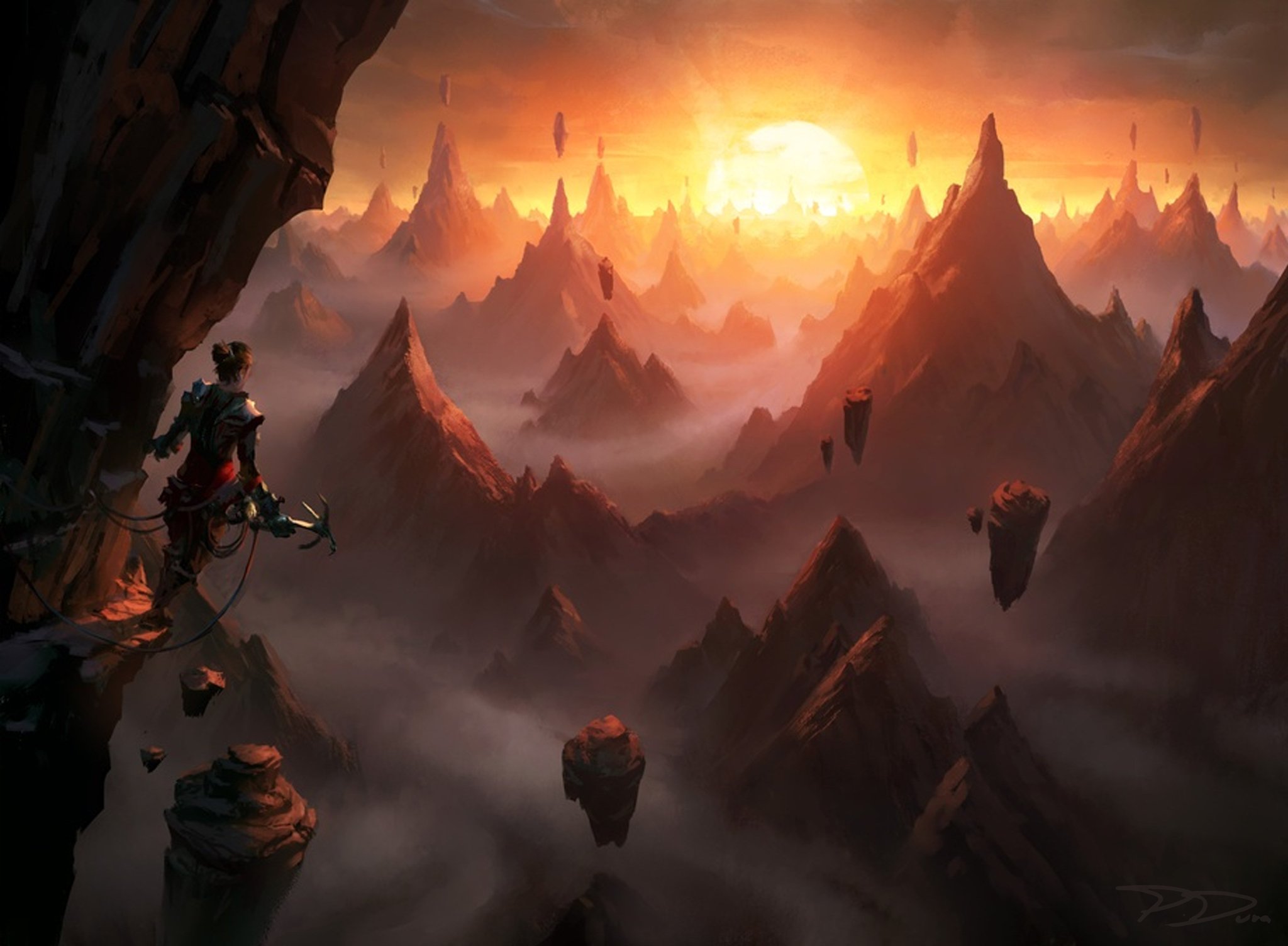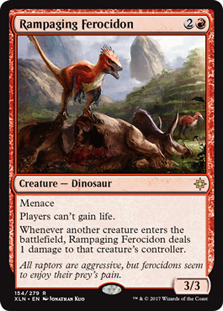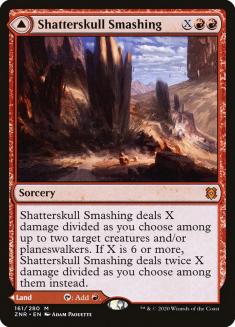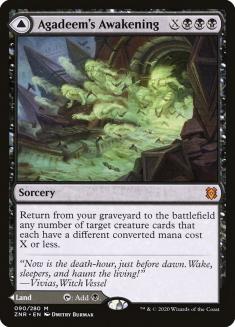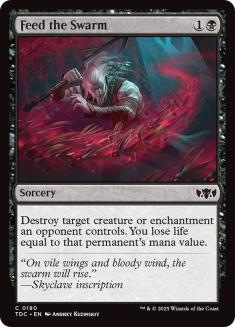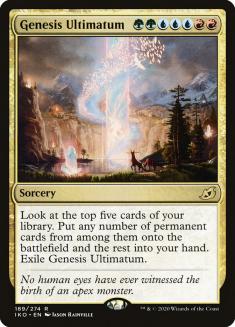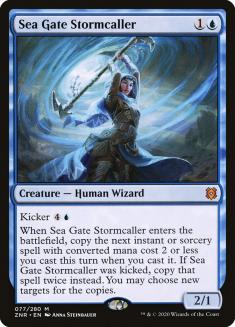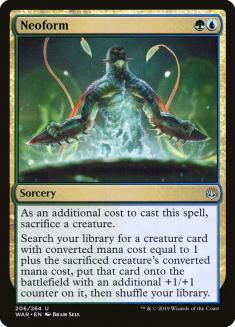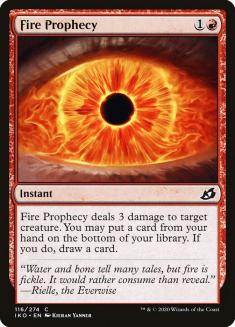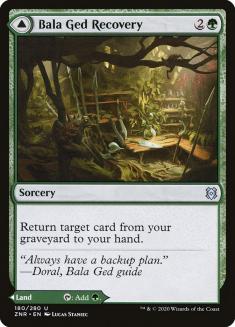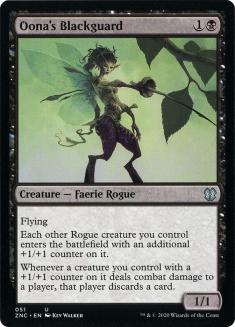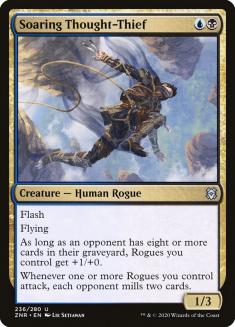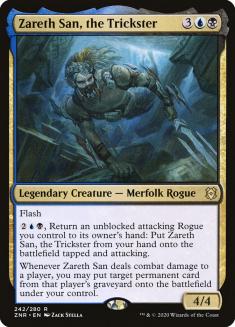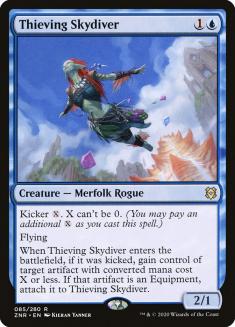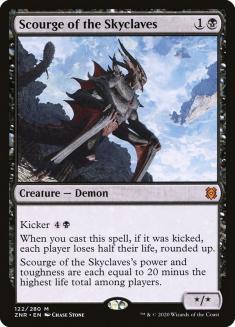There are a few notable winners in Historic coming out of Zendikar Rising in an overall high-impact set:
- Two-color decks with Pathways. Now they have a whopping twelve two-color lands and their mana is incredibly good. In particular, this should prop up Llanowar Elves strategies the most (a Gruul list will follow in this article). Nothing is fundamentally different, but being able to more consistently cast a Turn 1 Llanowar Elves and still support double-colored cards is a huge boon.
- Ramp, as usual. Omnath, Locus of Creation looks to be the strongest card in the set and there’s still plenty of ramp support in Historic with Growth Spiral and Explore remaining legal.
- Black got significantly better. Agadeem’s Awakening and Bloodchief’s Thirst are powerful for fueling various graveyard-based decks and granting some additional cheap interaction to pair with Thoughtseize. Black feels like one of the most complete and well-rounded colors in the format and can support a variety of macro-archetypes with its premium interaction.
The Updates
Creatures (31)
- 4 Llanowar Elves
- 3 Scavenging Ooze
- 2 Earthshaker Khenra
- 4 Rampaging Ferocidon
- 4 Pelt Collector
- 4 Gruul Spellbreaker
- 3 Questing Beast
- 4 Robber of the Rich
- 3 Bonecrusher Giant
Lands (21)
Spells (8)

The lists coming out of the Mythic Invitational sported Collected Company, but I’ve chosen to eschew it to support being more aggressive with Questing Beast and the extreme reliance that Gruul has on its sideboard and hate cards in general. Rampaging Ferocidon is one of the premium cards in the format for fighting Sacrifice and Goblins strategies, and being able to more consistently cast it Turn 2 with Llanowar Elves makes revisiting this archetype worth it.
Like I said previously, there’s nothing groundbreaking here, but picking up some more freerolled interaction in Shatterskull Smashing and better mana to support Embercleave and Questing Beast are big deals.
In the sideboard, you’ve likely seen most of the cards and they’re all important for fighting the various graveyard and win-from-the-top-of-the-library decks, but Roiling Vortex is another important Zendikar Rising card to pair with Rampaging Ferocidon. In particular, if Omnath does explode in popularity, the massive amount of life it threatens to generate between Omnath and Uro needs to be held in check by these cards.
An Oldie but a Goodie
Creatures (17)
- 2 Young Pyromancer
- 4 Stitcher's Supplier
- 4 Dreadhorde Arcanist
- 4 Kroxa, Titan of Death's Hunger
- 3 Archfiend's Vessel
Lands (21)
Spells (22)

This list is certainly not built perfectly, but Rakdos Arcanist is extremely complete now. It has every tool it needs to beat common hate cards with the addition of Feed the Swarm covering Rakdos’s key weakness — enchantments, specifically Leyline of the Void and Rest in Peace.
Additionally, Agadeem’s Awakening is another huge injection in power and is strong enough with Archfiend’s Vessel in particular to encourage me to go harder on the number of copies of it. Another benefit of the deck’s ability to fight hate is that it doesn’t need to lean as hard on Young Pyromancer. Previously Pyromancer was important despite having some glaring weaknesses — Goblin Chainwhirler, Mayhem Devil — since it lets you actually win the game if an opponent had one of the aforementioned pieces of hate. Being stronger with a wider swath of interaction means that Rakdos Arcanist can lean more heavily on the core aspects of its gameplan.
In terms of the balancing act there’s a lot to cover. Claim the Firstborn is nice in this deck since you’re already interested in enablers like Village Rites to begin with, but once you’re diversifying your interaction then there’s less room for cards like Spark Harvest. Additionally, flooding on Claims can really suck if you don’t successfully draw A + B, so while it looks weird to split cleanly the Harvest / Bloodchief’s Thirst / Feed the Swarm numbers, it still makes sense to me. since you need Bedevil to preemptively cover Grafdigger’s Cage and Nissa, Who Shakes the World as well.
Like I said, getting the details right here is going to be a (week by week) challenge, but Rakdos Arcanist is my pick for most improved deck since it was already such a monster in Game 1s and a lot of its problems have been shored up.
Here Come the Bad Guys
Creatures (13)
Planeswalkers (1)
Lands (28)
Spells (18)
Sideboard

While the construction of this archetype is fairly new, it’s also basically a Standard deck and is just another entry in the evolution of how Growth Spiral and Explore can take over Historic, so I’m just going to call it an update. To be honest, despite this just being a simple first crack, it’s not clear to me this deck has any real weaknesses.
Having an explosive and consistent ramp gameplan that’s elevated by Growth Spiral and Explore combined with the best per-slot interaction in Aether Gust, much improved mana over its Standard counterpart, and access to all the best hate cards in the format is an extremely robust package.
Omnath, Locus of Creation looks to be the strongest card in the set.
The unnaturally high amount of life that this deck generates now with Omnath paired with Uro means that it’s nearly impossible to get under it without a specific tool like Rampaging Ferocidon, so the only immediate challenge of competing with it on speed is Goblins, which you could go to even further lengths to cover effectively.
The only thing I’m really not confident on is how to construct this deck’s finisher package. Genesis Ultimatum doesn’t necessarily strike me as the best option, but it’s hard to deny how outrageous it can get with Lotus Cobra as early as the fourth turn, and even if you fail to completely combo off, there aren’t any decks that can really compete with a full turn involving Lotus Cobra, Omnath, and Genesis Ultimatum.
I’m not the biggest fan of Ugin either since it doesn’t have any obvious strengths against any of the top decks, but it is undeniably powerful and doesn’t mess around in a way that something like Thassa’s Oracle would if we were trying to construct this deck to win like a combo deck.
Felidar Retreat feels like the biggest compromise so far. It’s doing well in Standard lists and can function as a pseudo-combo kill card or just be naturally strong in competitive games accruing value and killing your opponent.
There’s definitely something here, as Omnath is slowly starting to show up across all the formats and maximizing it in this format on Turn 3 is clearly obtainable with Growth Spiral and Explore supporting Lotus Cobra.
The New Stuff
Zendikar Rising has also brought some really interesting new decks to Historic. To start with, here’s an archetype that I saw floating around Twitter a couple of weeks ago, most recently championed by yoman_5 (an excellent follow if you want to see a stream of brews) that I’ve tweaked a bit. I’m not sure where the list came from originally, but kudos as it’s an extremely creative idea.
Calling All Neoforms
Creatures (19)
- 4 Wall of Blossoms
- 1 Augur of Bolas
- 4 Dualcaster Mage
- 1 Klothys, God of Destiny
- 4 Sea Gate Stormcaller
- 4 Glasspool Mimic
- 1 Tuktuk Rubblefort
Lands (21)
Spells (20)

The basic idea is to cast Sea Gate Stormcaller and then a Neoform. The copied Neoform finds a Dualcaster Mage, which then copies the Neoform. You pull out all the Mages and Glasspool Mimics out of your deck, and then Tuktuk Rubblefort to give them all haste.
This isn’t an infinite damage combo, which means this deck naturally has quite a few problems. That said, it can interact and it is fast so it also has some strengths.
The original list played four copies of Augur of Bolas. The benefit of having an additional two-drop laying around when you go for the combo is that you can’t be broken up by a single removal spell killing the Sea Gate Stormcaller with its trigger on the stack.
Despite adding a ton of modal double-faced cards (DFCs) to the deck in the first version I built, Augur of Bolas still basically sucks and makes you look at the bottom three cards of your library too often. Wall of Blossoms is a pretty reasonable compromise that also has the added benefit of being a good blocker (that also happens to be pretty hard for red decks to remove in terms of breaking up your combo).
I cut the additional copy of Tuktuk and the Barrin, Tolarian Archmage for a Klothys: the former because it’s a terrible draw and I’m generally just going to hope that generating twenty or so power is good enough even if I can’t one-shot my opponents, as there aren’t a ton of sweepers running around the format; and the latter because if you’re actually unable to complete your kill because your opponent gained too much life or you happened to draw too many of your three-mana copy targets, then you’re typically only off by a couple of points, and even if you get swept, admittedly excluding Extinction Event, then Klothys should be able to get you over the finish line. It also happens to attack for five on your combo turn, so that’s a fair boost in your power output. Finally, if you do happen to draw it, it’s actually a reasonable card!
Fire Prophecy still makes sense to me as the primary removal spell in the deck since you are at risk of drawing mediocre cards every single draw step and need to assemble a two-card combo, but I’ve chosen to supplement it with Aether Gust, as it is pretty clearly to me by now that Aether Gust is the highest-impact interactive spell per slot in the format and covers the widest base.
I toned down the DFCs after playing for a while, but I’m sticking with a few copies of Bala Ged Recovery to make your deck a little more insulated against Thoughtseize, and I think it’s just a generally strong card, in particular when I’ve added more early green plays in Wall of Blossoms.
I think my sideboard probably sucks, particularly Magma Channeler. I know you want some kind of alternate win condition, and maybe Crackling Drake as in the original list is actually correct, but when you’re really cut off from doing your thing I think you want to be able to attack, and I’m failing to come up with what that should be.
The final benefit of the deck is that if you happen to be playing against a deck where a bunch of creature interaction is strong, you can just load up on it and your many copies of pseudo-Ravenous Chupacabras can likely get you over the finish line while you still have a combo finish in your back pocket.
I don’t think this deck is destined to be a Tier 1 part of the metagame, but I do think it is strong and worthy of further exploration; it just has a host of problems that may not be entirely solvable.
Going Rogue
Creatures (24)
- 4 Oona's Blackguard
- 2 Rankle, Master of Pranks
- 2 Brazen Borrower
- 4 Thieves' Guild Enforcer
- 1 Tinybones, Trinket Thief
- 4 Merfolk Windrobber
- 1 Zareth San, the Trickster
- 2 Thieving Skydiver
- 4 Soaring Thought-Thief
Lands (23)
Spells (13)

This is my pick for best new deck out of Zendikar Rising. Jumpstart offered a taste of what might be possible with Oona’s Blackguard, but now that Zendikar Rising has brought a large amount of support for Rogues, I think we have what could be a special breed of disruptive aggro deck.
Functional one-drops, eight lords, the best cheap interaction in the format, and some legitimately strong top-end are a lot to like in a deck. There’s nothing all that tricky here, despite the theme, but it’s just all quality and a strong manabase on top ties it all together. Drown in the Loch in particular is so extremely strong that most folks haven’t been exposed to it due to there not being a real home for it in Standard, but this is the deck it was made to be in.
Naturally, there’s the tension of a deck that fuels Uro, Titan of Nature’s Wrath, but I don’t think that’s a deal-breaker like it is in Zendikar Rising Standard. Thoughtseize and Oona’s Blackguard are a heavy-hitting disruptive package that can choke out any deck as Rogues get over the finish line.
Is Zareth San, the Trickster worth playing? I’m not sure, but it’s cool enough that I want to give it a chance, and Rankle is a very easy replacement if not.
The weirdest card to most people when looking at this decklist is likely Thieving Skydiver, but its creature type paired with the prevalence of Witch’s Oven in the format makes this an easy inclusion for me. Not to mention that even using its kicker to kill a Treasure against Goblins when it enters the battlefield is a meaningful impact on the matchup.
Finally, another format demands that I take another crack at Scourge of the Skyclaves.
Scourge of the Skyclaves?
Creatures (20)
Lands (14)
Spells (26)

Yeah, I really do want Scourge of the Skyclaves to work.
A larger format with Thoughtseize and other cheap interaction where you need a really fast clock to compete? Sounds like a recipe for a pseudo-Death’s Shadow.
That said, I’ll address the elephant in the room: Uro and Omnath might just be too much pressure to get Scourge onto the battlefield reliably. The fact that you need to pressure your opponent’s life total before you even deploy the Scourge and then it being potentially vulnerable for another turn or two is a big ask, but there’s also no independently high-ceiling threat in the format at such a low mana cost (which makes it worth considering and building around).
There are a bunch of weird tricks going on here, from the DFCs and Ifnir Deadlands being big sources of self-damage alongside Thoughtseize to an admittedly pretty weird-looking self-mill theme that eschews the normal package of Archfiend’s Vessel and Village Rites for Pteramander of all things. The logic is that reliably connecting against your opponent is important, and it feels like, between Agadeem’s Awakening, Pteramander, and new entry Skyclave Shade, this is all enough self-mill payoff despite not including many of the usual suspects.
This deck is weird, but the original Death’s Shadow looked weird too originally, until those lessons became standard deckbuilding practices. As Historic’s card pool continues to grow, there will be more and more incentive to get lean and building decks in this style is all about that natural progression.

